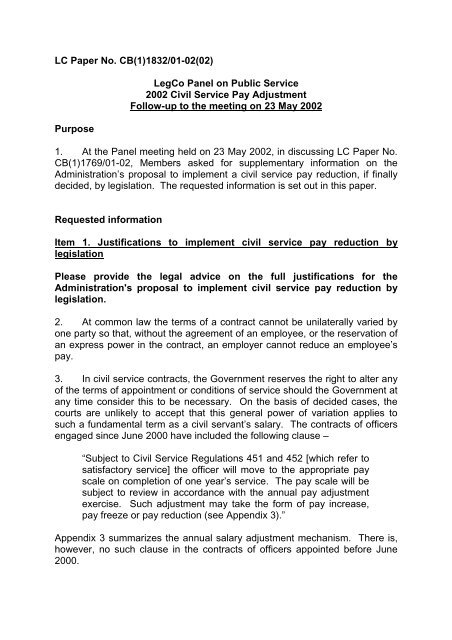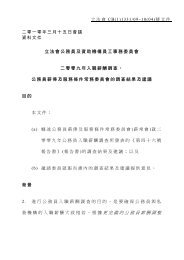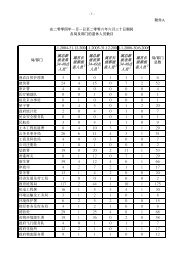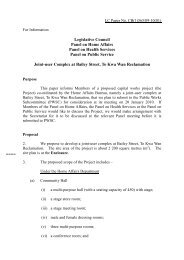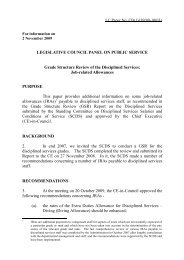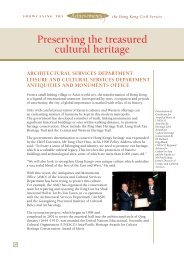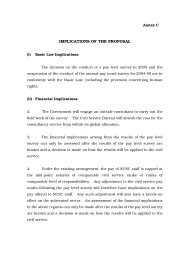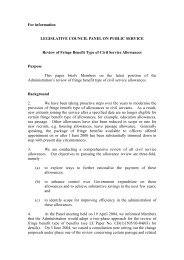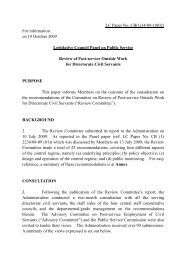LC Paper No. CB(1)1832/01-02(02) LegCo Panel on Public Service ...
LC Paper No. CB(1)1832/01-02(02) LegCo Panel on Public Service ...
LC Paper No. CB(1)1832/01-02(02) LegCo Panel on Public Service ...
You also want an ePaper? Increase the reach of your titles
YUMPU automatically turns print PDFs into web optimized ePapers that Google loves.
<str<strong>on</strong>g>LC</str<strong>on</strong>g> <str<strong>on</strong>g>Paper</str<strong>on</strong>g> <str<strong>on</strong>g>No</str<strong>on</strong>g>. <str<strong>on</strong>g>CB</str<strong>on</strong>g>(1)<str<strong>on</strong>g>1832</str<strong>on</strong>g>/<str<strong>on</strong>g>01</str<strong>on</strong>g>-<str<strong>on</strong>g>02</str<strong>on</strong>g>(<str<strong>on</strong>g>02</str<strong>on</strong>g>)<br />
Purpose<br />
<str<strong>on</strong>g>LegCo</str<strong>on</strong>g> <str<strong>on</strong>g>Panel</str<strong>on</strong>g> <strong>on</strong> <strong>Public</strong> <strong>Service</strong><br />
20<str<strong>on</strong>g>02</str<strong>on</strong>g> Civil <strong>Service</strong> Pay Adjustment<br />
Follow-up to the meeting <strong>on</strong> 23 May 20<str<strong>on</strong>g>02</str<strong>on</strong>g><br />
1. At the <str<strong>on</strong>g>Panel</str<strong>on</strong>g> meeting held <strong>on</strong> 23 May 20<str<strong>on</strong>g>02</str<strong>on</strong>g>, in discussing <str<strong>on</strong>g>LC</str<strong>on</strong>g> <str<strong>on</strong>g>Paper</str<strong>on</strong>g> <str<strong>on</strong>g>No</str<strong>on</strong>g>.<br />
<str<strong>on</strong>g>CB</str<strong>on</strong>g>(1)1769/<str<strong>on</strong>g>01</str<strong>on</strong>g>-<str<strong>on</strong>g>02</str<strong>on</strong>g>, Members asked for supplementary informati<strong>on</strong> <strong>on</strong> the<br />
Administrati<strong>on</strong>’s proposal to implement a civil service pay reducti<strong>on</strong>, if finally<br />
decided, by legislati<strong>on</strong>. The requested informati<strong>on</strong> is set out in this paper.<br />
Requested informati<strong>on</strong><br />
Item 1. Justificati<strong>on</strong>s to implement civil service pay reducti<strong>on</strong> by<br />
legislati<strong>on</strong><br />
Please provide the legal advice <strong>on</strong> the full justificati<strong>on</strong>s for the<br />
Administrati<strong>on</strong>'s proposal to implement civil service pay reducti<strong>on</strong> by<br />
legislati<strong>on</strong>.<br />
2. At comm<strong>on</strong> law the terms of a c<strong>on</strong>tract cannot be unilaterally varied by<br />
<strong>on</strong>e party so that, without the agreement of an employee, or the reservati<strong>on</strong> of<br />
an express power in the c<strong>on</strong>tract, an employer cannot reduce an employee’s<br />
pay.<br />
3. In civil service c<strong>on</strong>tracts, the Government reserves the right to alter any<br />
of the terms of appointment or c<strong>on</strong>diti<strong>on</strong>s of service should the Government at<br />
any time c<strong>on</strong>sider this to be necessary. On the basis of decided cases, the<br />
courts are unlikely to accept that this general power of variati<strong>on</strong> applies to<br />
such a fundamental term as a civil servant’s salary. The c<strong>on</strong>tracts of officers<br />
engaged since June 2000 have included the following clause –<br />
“Subject to Civil <strong>Service</strong> Regulati<strong>on</strong>s 451 and 452 [which refer to<br />
satisfactory service] the officer will move to the appropriate pay<br />
scale <strong>on</strong> completi<strong>on</strong> of <strong>on</strong>e year’s service. The pay scale will be<br />
subject to review in accordance with the annual pay adjustment<br />
exercise. Such adjustment may take the form of pay increase,<br />
pay freeze or pay reducti<strong>on</strong> (see Appendix 3).”<br />
Appendix 3 summarizes the annual salary adjustment mechanism. There is,<br />
however, no such clause in the c<strong>on</strong>tracts of officers appointed before June<br />
2000.
4. While at comm<strong>on</strong> law an employer could terminate employees’<br />
c<strong>on</strong>tracts by notice and offer them re-employment <strong>on</strong> a lower salary, the<br />
majority of civil servants have permanent c<strong>on</strong>tracts that cannot be terminated<br />
by notice and under which, subject to good c<strong>on</strong>duct, they are entitled to<br />
remain in office until they reach the retirement age prescribed by the Pensi<strong>on</strong>s<br />
Ordinances.<br />
5. While it might be possible for the Administrati<strong>on</strong> to reach such<br />
agreement with Civil <strong>Service</strong> Central C<strong>on</strong>sultative Councils <strong>on</strong> a civil service<br />
pay reducti<strong>on</strong>, such an agreement would not prevent individual civil servants<br />
from challenging any agreed pay reducti<strong>on</strong>. In the circumstances, the <strong>on</strong>ly<br />
safe way to achieve a lawful reducti<strong>on</strong> in civil service pay is through<br />
legislati<strong>on</strong>.<br />
6. For details <strong>on</strong> the need for legislati<strong>on</strong> to implement a civil service<br />
reducti<strong>on</strong>, please refer to the article prepared by Law Officer (Civil Law) at<br />
Annex A. The article, which also addresses the questi<strong>on</strong> of c<strong>on</strong>sistency of the<br />
proposed legislative approach with the Basic Law, was published in a number<br />
of newspapers <strong>on</strong> 24 May 20<str<strong>on</strong>g>02</str<strong>on</strong>g>.<br />
Item 2. Memorandum <strong>on</strong> C<strong>on</strong>diti<strong>on</strong>s of <strong>Service</strong> (MOCS)<br />
(a) Please provide various versi<strong>on</strong>s of MOCS applicable to civil<br />
servants and highlight the differences in their provisi<strong>on</strong>s. In particular,<br />
please set out whether the following clauses are included in each of the<br />
versi<strong>on</strong>s:<br />
⎯<br />
⎯<br />
⎯<br />
General clause (Clause 1.1 in MOCS (June 2000 versi<strong>on</strong>))<br />
"The officer is subject to Executive Orders issued from time to<br />
time by the Chief Executive for the administrati<strong>on</strong> of the public<br />
service and to regulati<strong>on</strong>s and directi<strong>on</strong>s made under these<br />
Orders."<br />
Clause relating to salary and increments (Clause 4.7 in<br />
MOCS (June 2000 versi<strong>on</strong>))<br />
"Subject to Civil <strong>Service</strong> Regulati<strong>on</strong>s 451 and 452, the officer<br />
will move to the appropriate pay scale <strong>on</strong> completi<strong>on</strong> of <strong>on</strong>e<br />
year's service. The pay scale will be subject to review in<br />
accordance with the annual pay adjustment exercise. Such<br />
adjustment may take the form of pay increase, pay freeze or<br />
pay reducti<strong>on</strong>."<br />
Variati<strong>on</strong> clause (Clause 23 in MOCS (June 2000 versi<strong>on</strong>))<br />
"<str<strong>on</strong>g>No</str<strong>on</strong>g>twithstanding anything c<strong>on</strong>tained in this Memorandum or<br />
in the covering letter of offer of appointment, the Government<br />
reserves the right to alter any of the officer's terms of<br />
appointment, and/or c<strong>on</strong>diti<strong>on</strong>s of service set out in this<br />
2
Memorandum or the said covering letter should the<br />
Government at any time c<strong>on</strong>sider this to be necessary."<br />
7. The employment arrangements for a civil servant are governed by the<br />
provisi<strong>on</strong>s set out in a letter of appointment and the Memorandum <strong>on</strong><br />
C<strong>on</strong>diti<strong>on</strong>s of <strong>Service</strong> (MOCS) attached to the letter. At present, there are a<br />
total of 11 sets of sample letter of appointment and 25 sets of standard MOCS<br />
(including those for retired and re-employed but excluding those tailored made<br />
by individual departments for their own staff, e.g. the H<strong>on</strong>g K<strong>on</strong>g Police Force)<br />
in the civil service to cater for the different types of terms of appointment for<br />
new recruits and serving officers <strong>on</strong> transfer or further appointment (a list of<br />
these sample appointment letters and MOCSs is at Annex B and a full set of<br />
these documents is deposited at the <str<strong>on</strong>g>LegCo</str<strong>on</strong>g> Secretariat for Members’<br />
reference). By and large, these MOCSs c<strong>on</strong>tain very similar provisi<strong>on</strong>s.<br />
Those clauses with a greater degree of variati<strong>on</strong> c<strong>on</strong>cern the fringe benefits to<br />
which officers are entitled under different terms of appointment.<br />
8. The various sets of MOCS are updated from time to time to reflect the<br />
changes to the Civil <strong>Service</strong> Regulati<strong>on</strong>s and other Government rules and<br />
regulati<strong>on</strong>s relating to the management of the civil service. For serving<br />
officers in the civil service, therefore, the MOCSs applicable to them differ<br />
from individual to individual depending <strong>on</strong> the date of their offer of<br />
appointment and the particular terms of their appointment. There are<br />
altogether over 200 sets of MOCSs introduced over the years which are<br />
currently still in force. Broadly speaking, the general clause (similar to clause<br />
1.1 of the June 2000 versi<strong>on</strong> of the MOCS) and the variati<strong>on</strong> clause (similar to<br />
clause 23 of GF 608 of the June 2000 versi<strong>on</strong> of the MOCS) (with very minor<br />
differences in drafting) have been included in most MOCSs for decades. In<br />
other words, these two provisi<strong>on</strong>s apply to most civil servants now serving in<br />
the Government. For the salary and increments clause, however, in all the<br />
MOCSs preceding the June 2000 versi<strong>on</strong>, it does not expressly stipulate that<br />
"the pay scale will be subject to review in accordance with the annual pay<br />
adjustment exercises and such adjustment may take the form of pay increase,<br />
pay freeze or pay reducti<strong>on</strong>" as in clause 4.7 of the June 2000 versi<strong>on</strong> of GF<br />
608.<br />
9. We estimate that about 2 700 officers have joined the Government<br />
since the June 2000 versi<strong>on</strong> of the MOCS came into force and another 2 700<br />
officers <strong>on</strong> agreement or retired and re-employment <strong>on</strong> agreement terms may<br />
have been issued with the June 2000 versi<strong>on</strong> of MOCS. But the employment<br />
c<strong>on</strong>tracts of the great majority of serving civil servants totally over 160 000 do<br />
not c<strong>on</strong>tain an express power to reduce pay.<br />
(b) Please provide the details of the legal advice <strong>on</strong> the reas<strong>on</strong>s why<br />
the variati<strong>on</strong> clause in MOCS is not sufficient for enabling the<br />
3
Government to reduce the pay of civil servants. In this c<strong>on</strong>necti<strong>on</strong>,<br />
please also provide details of the relevant court decisi<strong>on</strong>s menti<strong>on</strong>ed by<br />
the Law Officer (Civil Law) of the Department of Justice at the <str<strong>on</strong>g>Panel</str<strong>on</strong>g><br />
meeting.<br />
10. As menti<strong>on</strong>ed in the reply to 2(a) above, the MOCS applicable to<br />
officers appointed before June 2000 does not reserve an express power for<br />
the Government to reduce the appointee’s pay. Despite the decisi<strong>on</strong> of the<br />
H<strong>on</strong>g K<strong>on</strong>g Court of Appeal in Lam Yuk-ming v Attorney General [1980] HKLR<br />
815 in which the Court upheld the enforceability of the unilateral variati<strong>on</strong><br />
clause, a subsequent decisi<strong>on</strong> of the H<strong>on</strong>g K<strong>on</strong>g High Court in Fynn v<br />
Attorney General [1991] 1 HKLR 315 at 318 stated that –<br />
“There seems to be little doubt that there is nothing to prevent the<br />
Government from effecting changes and modificati<strong>on</strong>s to the<br />
various regulati<strong>on</strong>s relating to the employment. However, it is<br />
doubtful whether a basic alterati<strong>on</strong> could be made by the<br />
Government unilaterally such as changing the basis up<strong>on</strong> which<br />
the employee is to be remunerated.”<br />
11. That approach is supported by decisi<strong>on</strong>s in the U.K. such as United<br />
Associati<strong>on</strong>s for Protecti<strong>on</strong> of Trade Ltd. v Kilburn (17 September 1985,<br />
unreported) and the Court of Appeal’s decisi<strong>on</strong> in Wandsworth L<strong>on</strong>d<strong>on</strong><br />
Borough Council v D’Silva [1998] IRLR 193.<br />
(c) In c<strong>on</strong>necti<strong>on</strong> with item (b) above, if the variati<strong>on</strong> clause in MOCS<br />
is not sufficient for enabling the Government to reduce the pay of civil<br />
servants, please advise whether this means that there is no legal basis<br />
for the Government to reduce the pay of civil servants, and whether<br />
such reducti<strong>on</strong> in pay would c<strong>on</strong>travene Article 100 of the Basic Law.<br />
12. In view of the absence of an express power for the Government to<br />
reduce the pay of civil servants in most MOCSs currently in force, based <strong>on</strong><br />
decided court cases there is a serious risk that a decisi<strong>on</strong> to reduce civil<br />
service pay without legislati<strong>on</strong> would be subject to a successful legal<br />
challenge.<br />
13. The current proposal to reduce civil service pay is based <strong>on</strong> careful<br />
c<strong>on</strong>siderati<strong>on</strong> of all relevant factors under the established civil service pay<br />
adjustment mechanism including: the net pay trend indicators derived from the<br />
independent Pay Trend Survey, the state of the ec<strong>on</strong>omy, budgetary<br />
c<strong>on</strong>siderati<strong>on</strong>s, changes in the cost of living, the staff sides’ pay claims and<br />
civil service morale. This mechanism is flexible enough to allow for reducti<strong>on</strong>s<br />
as well as increases since some of these factors are capable of upward and<br />
downward movements. The Government is committed, and the staff sides of<br />
the central c<strong>on</strong>sultative councils have also hitherto urged the Government, to<br />
4
follow the established mechanism in deciding the size of this year’s pay<br />
adjustment. The proposed legislati<strong>on</strong> is a means to ensure that a justified<br />
decisi<strong>on</strong> made under the established mechanism can be implemented fairly<br />
and with certainty.<br />
14. Article 100 of the Basic Law provides that public servants serving in all<br />
H<strong>on</strong>g K<strong>on</strong>g Government departments before the establishment of the H<strong>on</strong>g<br />
K<strong>on</strong>g SAR “may all remain in employment and retain their seniority with pay,<br />
allowances, benefits and c<strong>on</strong>diti<strong>on</strong>s of service no less favourable than before.”<br />
Assuming that any pay reducti<strong>on</strong> does not reduce the salaries of civil servants<br />
who were serving immediately before 1 July 1997 to a level below that which<br />
they were receiving <strong>on</strong> that date, there would be no breach of that article.<br />
Item 3. Basic Law implicati<strong>on</strong>s<br />
Please provide the legal advice <strong>on</strong> the interpretati<strong>on</strong> of "no less<br />
favourable than before" under Article 100 of the Basic Law.<br />
15. While it is arguable that “no less favourable than before” in Article 100<br />
of the Basic Law could be c<strong>on</strong>strued to take account of changes in the cost of<br />
living, that issue does not arise in the c<strong>on</strong>text of the present proposed<br />
reducti<strong>on</strong> since even after the reducti<strong>on</strong>, the pay of civil servants would still be<br />
at or above the level in cash terms that they were receiving <strong>on</strong> 30 June 1997.<br />
Item 4. Independent Committee of Inquiry<br />
(a) Please c<strong>on</strong>sider other alternatives to implement the pay reducti<strong>on</strong>,<br />
e.g. by using the existing mechanism provided under the 1968<br />
Agreement between the H<strong>on</strong>g K<strong>on</strong>g Government and the Main Staff<br />
Associati<strong>on</strong>s (the1968 Agreement) to appoint an independent Committee<br />
of Inquiry to deal with the issue.<br />
16. There is no other alternative to legislati<strong>on</strong> which will enable the<br />
Government to implement the pay reducti<strong>on</strong>, which is a reas<strong>on</strong>able decisi<strong>on</strong><br />
made under the established pay adjustment mechanism, with certainty. The<br />
1968 Agreement between the H<strong>on</strong>g K<strong>on</strong>g Government and certain staff<br />
associati<strong>on</strong>s does not form part of the existing civil service pay adjustment<br />
mechanism. Any request for the appointment of a Committee of Inquiry under<br />
the 1968 Agreement will have to be justified <strong>on</strong> merit and is subject to the<br />
decisi<strong>on</strong> of the Chief Executive.<br />
(b) If the Chief Executive so decides or the main staff associati<strong>on</strong>s so<br />
request to appoint an independent Committee of Inquiry to deal with the<br />
issue, please c<strong>on</strong>firm whether the Government would defer the<br />
introducti<strong>on</strong> of the proposed <strong>Public</strong> Officers Pay Adjustment Bill into<br />
<str<strong>on</strong>g>LegCo</str<strong>on</strong>g>.<br />
5
17. Since the 1968 Agreement is not part of the pay adjustment<br />
mechanism, there would be no necessary c<strong>on</strong>necti<strong>on</strong> between a decisi<strong>on</strong> to<br />
appoint an independent Committee of Inquiry and the decisi<strong>on</strong> to introduce the<br />
proposed Bill into <str<strong>on</strong>g>LegCo</str<strong>on</strong>g>.<br />
(c) Please c<strong>on</strong>firm whether the recommendati<strong>on</strong>s of a Committee of<br />
Inquiry are binding <strong>on</strong> the Government and all civil servants.<br />
18. The recommendati<strong>on</strong>s of a Committee of Inquiry are not binding <strong>on</strong><br />
either the Government or the staff associati<strong>on</strong>s who are parties to the<br />
agreement unless they are accepted by both the Government and the<br />
associati<strong>on</strong>s. Even if they were accepted by both the Government and the<br />
associati<strong>on</strong>s, they would not bind associati<strong>on</strong>s who are not parties to the 1968<br />
Agreement nor would they bind individual civil servants, even if they are<br />
members of the relevant associati<strong>on</strong>s.<br />
Item 5. Draft <strong>Public</strong> Officers Pay Adjustment Bill<br />
(a) Please explain the intent and effect of clause 9 (Compensati<strong>on</strong>,<br />
remedies etc.) of the Draft Bill.<br />
19. Clause 9 of the Bill as presently drafted is intended to expressly<br />
authorize the adjustments to pay and allowances made by the ordinance<br />
when enacted and to clarify that following enactment a public officer will not<br />
directly or indirectly be able to recover the amount of the reducti<strong>on</strong> by way of<br />
compensati<strong>on</strong> or damages.<br />
(b) Please provide the justificati<strong>on</strong>s for not allowing amendments to<br />
the Bill.<br />
20. Amendments to a Bill under c<strong>on</strong>siderati<strong>on</strong> by the Legislative Council<br />
may be moved subject to compliance with the procedural rules <strong>on</strong> the form<br />
and c<strong>on</strong>tents of such amendments as set out in Rule 54 of the Rules of<br />
Procedures of the Legislative Council.<br />
6
Annex A<br />
Civil <strong>Service</strong> Pay : the legal issues<br />
1. The current debate c<strong>on</strong>cerning a possible reducti<strong>on</strong> in civil service<br />
pay has thrown up important legal issues. Would a pay reducti<strong>on</strong> be lawful<br />
and c<strong>on</strong>sistent with the Basic Law?<br />
2. The Department of Justice is c<strong>on</strong>fident that a limited pay reducti<strong>on</strong>,<br />
achieved through legislati<strong>on</strong>, would be both lawful and c<strong>on</strong>sistent with the<br />
Basic Law.<br />
Pay adjustment mechanism<br />
3. The current pay adjustment mechanism takes into account the net<br />
pay trend indicators derived from the pay trend survey, the state of the ec<strong>on</strong>omy,<br />
budgetary c<strong>on</strong>siderati<strong>on</strong>s, movements in the cost of living, the Staff Sides’ pay<br />
claims and civil service morale. It is flexible enough to take account of<br />
reducti<strong>on</strong>s as well as increases, since some of these factors are capable of<br />
upward and downward movements. But if the result of applying these factors<br />
suggests that there should be a reducti<strong>on</strong> of pay, the questi<strong>on</strong> now is how best<br />
we could achieve it.<br />
The need for legislati<strong>on</strong><br />
4. As a general rule, the terms of a c<strong>on</strong>tract cannot be unilaterally<br />
varied by <strong>on</strong>e party. And so, without the agreement of the employee, an<br />
employer cannot generally reduce an employee’s pay.<br />
5. In civil servants’ c<strong>on</strong>tracts, the Government reserves the right<br />
(normally in clause 20) to alter any of the terms of appointment or c<strong>on</strong>diti<strong>on</strong>s of<br />
service should the Government at any time c<strong>on</strong>sider this to be necessary. This<br />
might appear to give the Government the right to reduce salaries unilaterally.<br />
But decided cases indicate that the courts are unlikely to accept that this general<br />
power of variati<strong>on</strong> applies to such a fundamental term as the salary. It would<br />
therefore not be safe to regard that provisi<strong>on</strong> as authorising a unilateral pay<br />
reducti<strong>on</strong>.<br />
6. There is another route that is open to some employers. They may<br />
be able to terminate employees’ c<strong>on</strong>tracts by notice and offer them re-
- 2 -<br />
employment <strong>on</strong> a lower salary. However, a large proporti<strong>on</strong> of civil servants<br />
have permanent c<strong>on</strong>tracts that cannot be terminated by notice. For those<br />
without permanent c<strong>on</strong>tracts, the terminati<strong>on</strong> route is theoretically possible.<br />
But the prospect of dismissing civil servants en masse, with no guarantee that<br />
they would accept re-employment <strong>on</strong> lower salaries, would raise serious<br />
c<strong>on</strong>cerns about the smooth operati<strong>on</strong> of the Government, and of deliveries of<br />
services to the public.<br />
7. It has been suggested that there is a further route open to the<br />
government, namely to reach an agreement with the civil service. However,<br />
even if such an agreement were reached with civil service central c<strong>on</strong>sultative<br />
councils, it would not prevent individual civil servants from challenging any<br />
agreed pay reducti<strong>on</strong>.<br />
8. Faced with these difficulties, the <strong>on</strong>ly safe way to achieve a lawful<br />
reducti<strong>on</strong> in civil service pay is through legislati<strong>on</strong>. If legislati<strong>on</strong> to reduce<br />
pay is enacted the risk of a successful legal challenge would be significantly<br />
reduced.<br />
Basic Law issues<br />
9. But if there is to be a civil service pay reducti<strong>on</strong>, would it be lawful<br />
and c<strong>on</strong>sistent with the Basic Law? And if so, would any legislati<strong>on</strong> to give<br />
effect to such pay reducti<strong>on</strong> be c<strong>on</strong>sistent with the Basic Law?<br />
10. Article 100 provides that public servants serving in all H<strong>on</strong>g K<strong>on</strong>g<br />
government departments before the establishment of the H<strong>on</strong>g K<strong>on</strong>g SAR “may<br />
all remain in employment and retain their seniority with pay, allowances,<br />
benefits and c<strong>on</strong>diti<strong>on</strong>s of service no less favourable than before.” Assuming<br />
that the pay reducti<strong>on</strong> does not make the salaries of civil servants lower than<br />
they were <strong>on</strong> 30 June 1997, there would be no breach of that Article.<br />
11. Moreover, in a case decided in 1998, the court held that Article 100<br />
was intended to ensure c<strong>on</strong>tinuity of employment so that no public servant<br />
suffers as a c<strong>on</strong>sequence of the transiti<strong>on</strong> itself, but was not intended to inhibit<br />
the introducti<strong>on</strong> of new measures for the good governance of H<strong>on</strong>g K<strong>on</strong>g. The<br />
Associati<strong>on</strong> of Expatriate Civil Servants had challenged the introducti<strong>on</strong>, after<br />
Reunificati<strong>on</strong>, of a Chinese language proficiency requirement for those civil<br />
servants who wished to transfer to permanent terms of service. After<br />
explaining the purpose of Article 100, the court held that it had not been<br />
breached by the introducti<strong>on</strong> of this new requirement.<br />
12. Article 103 of the Basic Law provides that H<strong>on</strong>g K<strong>on</strong>g’s previous<br />
system of management for the public service, including special bodies for
- 3 -<br />
advising <strong>on</strong> their pay and c<strong>on</strong>diti<strong>on</strong>s, shall be maintained. The emphasis here<br />
is <strong>on</strong> the system, rather than <strong>on</strong> the pay and c<strong>on</strong>diti<strong>on</strong>s themselves.<br />
13. The system for pay adjustments, which has been in place since<br />
1974, has been described earlier. The applicati<strong>on</strong> of that system this year<br />
reflects the downward trend of relevant factors and, in particular, the downturn<br />
in the ec<strong>on</strong>omy and our deficit budget. If the revised pay levels give full effect<br />
to the established system, there would therefore be no breach of Article 103.<br />
14. Article 160 of the Basic Law provides that c<strong>on</strong>tracts, and rights and<br />
obligati<strong>on</strong>s valid under the laws previously in force in H<strong>on</strong>g K<strong>on</strong>g shall<br />
c<strong>on</strong>tinue to be valid and be recognized and protected by the H<strong>on</strong>g K<strong>on</strong>g SAR,<br />
provided that they do not c<strong>on</strong>travene the Basic Law. The c<strong>on</strong>tractual rights of<br />
civil servants who were employed <strong>on</strong> 30 June 1997 are within this provisi<strong>on</strong>.<br />
But the pay of those who remain in Government employment has been<br />
increased since that date by between 4.99% (for directorate officers at D3 and<br />
above) and 11.32%.<br />
15. Assuming that the proposed pay reducti<strong>on</strong>s would not bring<br />
salaries to a level below that <strong>on</strong> 30 June 1997, the right to the salary as at that<br />
date would be fully recognized and protected.<br />
16. Can it be argued that the rights protected by Article 160 include a<br />
right not to have any legislative interference with a subsisting c<strong>on</strong>tract? Given<br />
that laws previously in force can be amended by legislati<strong>on</strong>, provided that the<br />
amendments are c<strong>on</strong>sistent with the Basic Law, it would be extraordinary if<br />
c<strong>on</strong>tractual rights could not be modified by legislati<strong>on</strong>. Article 160 cannot<br />
have been intended to have that effect. It is primarily a savings provisi<strong>on</strong>, to<br />
ensure that c<strong>on</strong>tractual rights did not fall away as a result of Reunificati<strong>on</strong>.<br />
17. The proposed pay reducti<strong>on</strong> has taken full account of all relevant<br />
factors under the established civil service pay adjustment mechanism, which is<br />
itself c<strong>on</strong>sistent with Article 103 of the Basic Law. The legislative approach<br />
now proposed would simply be a new measure to give effect to a justified<br />
decisi<strong>on</strong> made under the established mechanism. Applying the reas<strong>on</strong>ing that<br />
governs Article 100, it would also be a measure for the good governance of<br />
H<strong>on</strong>g K<strong>on</strong>g. Thus, the proposed legislative pay reducti<strong>on</strong> is c<strong>on</strong>sistent with<br />
the Basic Law. The argument that Article 160 prohibits such a reducti<strong>on</strong><br />
cannot therefore be accepted.
- 4 -<br />
C<strong>on</strong>clusi<strong>on</strong><br />
18. The proposed pay reducti<strong>on</strong> is c<strong>on</strong>troversial. But the legal issues<br />
should be put <strong>on</strong> <strong>on</strong>e side. It is clear that, if there is to be a reducti<strong>on</strong>,<br />
legislati<strong>on</strong> is needed. And it is clear that a limited pay reducti<strong>on</strong> would be<br />
c<strong>on</strong>sistent with the Basic Law.
Annex B<br />
List of Letters of Appointment and Memorandum <strong>on</strong> C<strong>on</strong>diti<strong>on</strong>s of <strong>Service</strong><br />
Within the Civil <strong>Service</strong><br />
I. List of appointment letters<br />
Specimen Letter <str<strong>on</strong>g>No</str<strong>on</strong>g>.<br />
Title<br />
AL1 (August 20<str<strong>on</strong>g>01</str<strong>on</strong>g>) Specimen Letter of Appointment <strong>on</strong><br />
Probati<strong>on</strong>ary/M<strong>on</strong>th-to-M<strong>on</strong>th Terms<br />
AL2 (August 20<str<strong>on</strong>g>01</str<strong>on</strong>g>)<br />
Specimen Letter of Appointment <strong>on</strong> Agreement Terms<br />
AL3 (August 20<str<strong>on</strong>g>01</str<strong>on</strong>g>)<br />
Specimen Letter of Appointment <strong>on</strong> Day-to-Day Terms<br />
AL4 (August 20<str<strong>on</strong>g>01</str<strong>on</strong>g>)<br />
AL5 (August 20<str<strong>on</strong>g>01</str<strong>on</strong>g>)<br />
AL6 (April 20<str<strong>on</strong>g>02</str<strong>on</strong>g>)<br />
AL7 (April 20<str<strong>on</strong>g>02</str<strong>on</strong>g>)<br />
AL8 (April 20<str<strong>on</strong>g>02</str<strong>on</strong>g>)<br />
AL9 (April 20<str<strong>on</strong>g>02</str<strong>on</strong>g>)<br />
AL10 (April 20<str<strong>on</strong>g>02</str<strong>on</strong>g>)<br />
AL11 (April 20<str<strong>on</strong>g>02</str<strong>on</strong>g>)<br />
Specimen Letter of Appointment <strong>on</strong> Trial Terms<br />
Specimen Letter of C<strong>on</strong>firmati<strong>on</strong>/Withdrawal of Offer<br />
of Appointment after Pre-employment Medical<br />
Examinati<strong>on</strong> (if required)<br />
Specimen letter to an overseas agreement officer<br />
offering transfer to locally modelled c<strong>on</strong>diti<strong>on</strong>s<br />
Specimen letter to a transferee offering a further agreement<br />
<strong>on</strong> locally modelled c<strong>on</strong>diti<strong>on</strong>s<br />
Specimen letter of offer of re-employment to officers who<br />
retire from the service and are re-employed <strong>on</strong><br />
m<strong>on</strong>th-to-m<strong>on</strong>th terms without a break in service under the<br />
new pensi<strong>on</strong> scheme<br />
Specimen letter of offer of re-employment to officers<br />
who retire from the service and are re-employed in the<br />
same rank <strong>on</strong> agreement terms without a break in<br />
service under the new pensi<strong>on</strong> scheme<br />
Specimen letter of offer of re-employment to officers who<br />
retire from the service and are re-employed <strong>on</strong> agreement<br />
terms without a break in service under the old pensi<strong>on</strong><br />
scheme (CSR 270(1))<br />
Specimen letter of offer of re-employment to officers who<br />
retire from the service and are re-employed <strong>on</strong><br />
m<strong>on</strong>th-to-m<strong>on</strong>th terms without a break in service under the<br />
old pensi<strong>on</strong> scheme (CSR 270(2))<br />
1
II.<br />
List of Memorandum <strong>on</strong> C<strong>on</strong>diti<strong>on</strong>s of <strong>Service</strong><br />
Form <str<strong>on</strong>g>No</str<strong>on</strong>g>.<br />
GF 3<str<strong>on</strong>g>01</str<strong>on</strong>g> (revised August 20<str<strong>on</strong>g>01</str<strong>on</strong>g>)<br />
GF 305 (revised August 20<str<strong>on</strong>g>01</str<strong>on</strong>g>)<br />
GF 306 (revised August 20<str<strong>on</strong>g>01</str<strong>on</strong>g>)<br />
GF 306A FVL(NRS)<br />
(revised August 20<str<strong>on</strong>g>01</str<strong>on</strong>g>)<br />
GF 341 (revised August 20<str<strong>on</strong>g>01</str<strong>on</strong>g>)<br />
GF 341A (revised August 20<str<strong>on</strong>g>01</str<strong>on</strong>g>)<br />
GF 341BAP<br />
(revised August 20<str<strong>on</strong>g>01</str<strong>on</strong>g>)<br />
GF 341BAP2<br />
(August 20<str<strong>on</strong>g>01</str<strong>on</strong>g>)<br />
Title<br />
Memorandum <strong>on</strong> C<strong>on</strong>diti<strong>on</strong>s of <strong>Service</strong> for<br />
officers <strong>on</strong> local probati<strong>on</strong>ary/trial terms<br />
(with pay points at D3 or below or equivalent)<br />
Memorandum <strong>on</strong> C<strong>on</strong>diti<strong>on</strong>s of <strong>Service</strong> for<br />
officers <strong>on</strong> m<strong>on</strong>th-to-m<strong>on</strong>th terms<br />
Memorandum <strong>on</strong> C<strong>on</strong>diti<strong>on</strong>s of <strong>Service</strong> for<br />
officers <strong>on</strong> Model Salary Scale I<br />
Memorandum <strong>on</strong> C<strong>on</strong>diti<strong>on</strong>s of <strong>Service</strong> for<br />
officers who retire and are re-employed<br />
without a break in service <strong>on</strong> m<strong>on</strong>th-to-m<strong>on</strong>th<br />
terms<br />
Memorandum <strong>on</strong> C<strong>on</strong>diti<strong>on</strong>s of <strong>Service</strong> for<br />
(a) overseas agreement officers <strong>on</strong> MPS<br />
34-44 or equivalent appointed before<br />
1.8.1987 who opt to remain <strong>on</strong><br />
vacati<strong>on</strong> leave terms under CSR 1265;<br />
or<br />
(b) overseas agreement officers <strong>on</strong> MPS<br />
33 and below or equivalent who are<br />
appointed before 15.6.1988 and<br />
remain <strong>on</strong> vacati<strong>on</strong> leave terms under<br />
CSR 1266.<br />
Memorandum <strong>on</strong> C<strong>on</strong>diti<strong>on</strong>s of <strong>Service</strong> for<br />
officers <strong>on</strong> overseas agreement terms<br />
(with pay points at MPS 34 or above or<br />
equivalent <strong>on</strong> annual leave terms)<br />
Memorandum <strong>on</strong> C<strong>on</strong>diti<strong>on</strong>s of <strong>Service</strong> for<br />
officers <strong>on</strong> local agreement terms<br />
(with pay points at D4 or above or equivalent)<br />
Memorandum <strong>on</strong> C<strong>on</strong>diti<strong>on</strong>s of <strong>Service</strong> for<br />
officers <strong>on</strong> local agreement terms<br />
(with pay points at D4 or above or equivalent)<br />
(<str<strong>on</strong>g>No</str<strong>on</strong>g>te : This Memorandum is for Directorate<br />
officers at D4 or above or equivalent<br />
who (a) have opted to transfer to<br />
2
GF 341BAP OL2<br />
(revised August 20<str<strong>on</strong>g>01</str<strong>on</strong>g>)<br />
GF 341D (NRS)<br />
(revised October 20<str<strong>on</strong>g>01</str<strong>on</strong>g>)<br />
GF 341D (NRS)2<br />
(revised August 20<str<strong>on</strong>g>01</str<strong>on</strong>g>)<br />
GF 341F<br />
(revised August 20<str<strong>on</strong>g>01</str<strong>on</strong>g>)<br />
GF 341FVL<br />
(revised August 20<str<strong>on</strong>g>01</str<strong>on</strong>g>)<br />
revised leave and passage<br />
arrangements in accordance with<br />
CSB Circular <str<strong>on</strong>g>No</str<strong>on</strong>g>. 7/98 or (b) were<br />
promoted to D4 or above or<br />
equivalent <strong>on</strong> or after 1 April 1998.)<br />
Memorandum <strong>on</strong> C<strong>on</strong>diti<strong>on</strong>s of <strong>Service</strong> for<br />
officers <strong>on</strong> locally modelled agreement terms<br />
(with pay points at D4 or above or equivalent)<br />
Memorandum <strong>on</strong> C<strong>on</strong>diti<strong>on</strong>s of <strong>Service</strong> for<br />
officers who retire and are re-employed<br />
without a break in service <strong>on</strong> overseas<br />
agreement terms<br />
(with pay points at MPS 34 or above or<br />
equivalent <strong>on</strong> annual leave terms)<br />
Memorandum <strong>on</strong> C<strong>on</strong>diti<strong>on</strong>s of <strong>Service</strong> for<br />
officers who retire and are re-employed<br />
without a break in service <strong>on</strong> overseas<br />
agreement terms<br />
(with pay points at D4 or above or equivalent)<br />
(<str<strong>on</strong>g>No</str<strong>on</strong>g>te: This Memorandum is for directorate<br />
officers <strong>on</strong> overseas terms with pay<br />
points at D4 or above or equivalent<br />
who have opted to transfer to revised<br />
leave and passage arrangements in<br />
accordance with CSB Circular <str<strong>on</strong>g>No</str<strong>on</strong>g>.<br />
7/98)<br />
Memorandum <strong>on</strong> C<strong>on</strong>diti<strong>on</strong>s of <strong>Service</strong> for<br />
officers <strong>on</strong> overseas agreement terms<br />
(with pay points at D4 or above or equivalent)<br />
(<str<strong>on</strong>g>No</str<strong>on</strong>g>te : This Memorandum is for directorate<br />
officers <strong>on</strong> overseas terms with pay<br />
points at D4 or above or equivalent<br />
who have opted to transfer to revised<br />
leave and passage arrangements in<br />
accordance with CSB Circular <str<strong>on</strong>g>No</str<strong>on</strong>g>.<br />
7/98.)<br />
Memorandum <strong>on</strong> C<strong>on</strong>diti<strong>on</strong>s of <strong>Service</strong> for<br />
officers <strong>on</strong> overseas agreement terms<br />
3
GF 341T<br />
(revised August 20<str<strong>on</strong>g>01</str<strong>on</strong>g>)<br />
GF 392BAP(NRS)<br />
(revised August 20<str<strong>on</strong>g>01</str<strong>on</strong>g>)<br />
GF 392BAP(NRS)2<br />
(revised August 20<str<strong>on</strong>g>01</str<strong>on</strong>g>)<br />
(with pay points at MPS 33 or below or<br />
equivalent <strong>on</strong> flexible vacati<strong>on</strong> leave terms)<br />
Memorandum <strong>on</strong> C<strong>on</strong>diti<strong>on</strong>s of <strong>Service</strong> for<br />
officers <strong>on</strong> overseas trial terms<br />
(with pay points at D3 or below or equivalent)<br />
Memorandum <strong>on</strong> C<strong>on</strong>diti<strong>on</strong>s of <strong>Service</strong> for<br />
officers who retire and are re-employed<br />
without a break in service <strong>on</strong> local agreement<br />
terms<br />
(with pay points at D4 or above or equivalent)<br />
Memorandum <strong>on</strong> C<strong>on</strong>diti<strong>on</strong>s of <strong>Service</strong> for<br />
officers who retire and are re-employed<br />
without a break in service <strong>on</strong> local agreement<br />
terms<br />
(with pay points at D4 or above or equivalent)<br />
(<str<strong>on</strong>g>No</str<strong>on</strong>g>te: This Memorandum is for Directorate<br />
officers at D4 or above or equivalent<br />
who (a) have opted to transfer to<br />
revised leave and passage<br />
arrangements in accordance with<br />
CSB Circular <str<strong>on</strong>g>No</str<strong>on</strong>g>. 7/98 or (b) were<br />
promoted to D4 or above or<br />
equivalent <strong>on</strong> or after 1 April 1998)<br />
GF 392FVL<br />
(revised August 20<str<strong>on</strong>g>01</str<strong>on</strong>g>)<br />
GF 392FVL OL2<br />
(revised August 20<str<strong>on</strong>g>01</str<strong>on</strong>g>)<br />
GF 392FVL (NRS)<br />
(revised August 20<str<strong>on</strong>g>01</str<strong>on</strong>g>)<br />
GF 307<br />
(Revised August 20<str<strong>on</strong>g>01</str<strong>on</strong>g>)<br />
Memorandum <strong>on</strong> C<strong>on</strong>diti<strong>on</strong>s of <strong>Service</strong> for<br />
officers <strong>on</strong> local agreement terms<br />
(with pay points at D3 or below or equivalent)<br />
Memorandum <strong>on</strong> C<strong>on</strong>diti<strong>on</strong>s of <strong>Service</strong> for<br />
officers <strong>on</strong> locally modelled agreement terms<br />
(with pay points at D3 or below or equivalent)<br />
Memorandum <strong>on</strong> C<strong>on</strong>diti<strong>on</strong>s of <strong>Service</strong> for<br />
officers who retire and are re-employed<br />
without a break in service <strong>on</strong> local agreement<br />
terms<br />
(with pay points at D3 or below or equivalent)<br />
Memorandum <strong>on</strong> C<strong>on</strong>diti<strong>on</strong>s of <strong>Service</strong> for<br />
Officers Appointed <strong>on</strong> Comm<strong>on</strong><br />
Probati<strong>on</strong>ary/Trial Terms<br />
4
GF 308<br />
(Revised August 20<str<strong>on</strong>g>01</str<strong>on</strong>g>)<br />
GF 309<br />
(Revised August 20<str<strong>on</strong>g>01</str<strong>on</strong>g>)<br />
GF 310<br />
(Revised August 20<str<strong>on</strong>g>01</str<strong>on</strong>g>)<br />
GF 607<br />
(June 2000)<br />
GF 608<br />
(June 2000)<br />
Memorandum <strong>on</strong> C<strong>on</strong>diti<strong>on</strong>s of <strong>Service</strong> for<br />
Officers Appointed <strong>on</strong> Comm<strong>on</strong><br />
M<strong>on</strong>th-to-M<strong>on</strong>th Terms<br />
Memorandum <strong>on</strong> C<strong>on</strong>diti<strong>on</strong>s of <strong>Service</strong> for<br />
Model Salary Scale I officers Appointed <strong>on</strong><br />
Comm<strong>on</strong> M<strong>on</strong>th-to-M<strong>on</strong>th Terms<br />
Memorandum <strong>on</strong> C<strong>on</strong>diti<strong>on</strong>s of <strong>Service</strong> for<br />
Officers Appointed <strong>on</strong> Comm<strong>on</strong> Agreement<br />
Terms<br />
Memorandum <strong>on</strong> C<strong>on</strong>diti<strong>on</strong>s of <strong>Service</strong> for<br />
Officers Appointed <strong>on</strong> New Probati<strong>on</strong>ary<br />
Terms<br />
<str<strong>on</strong>g>No</str<strong>on</strong>g>te : This Memorandum <strong>on</strong> C<strong>on</strong>diti<strong>on</strong>s of<br />
<strong>Service</strong> is applied to -<br />
(a) new recruits who are first offered<br />
appointment <strong>on</strong> or after 1 June 2000; or<br />
(b) officers who are offered re-appointment to<br />
the civil service with a break in service <strong>on</strong><br />
or after 1 June 2000<br />
Memorandum <strong>on</strong> C<strong>on</strong>diti<strong>on</strong>s of <strong>Service</strong> for<br />
Officers Appointed <strong>on</strong> New Agreement Terms<br />
<str<strong>on</strong>g>No</str<strong>on</strong>g>te : This Memorandum <strong>on</strong> C<strong>on</strong>diti<strong>on</strong>s of<br />
<strong>Service</strong> is applied to -<br />
(a) new recruits who are first offered<br />
appointment <strong>on</strong> or after 1 June 2000; or<br />
(b) officers who are offered re-appointment to<br />
the civil service with a break in service <strong>on</strong><br />
or after 1 June 2000<br />
5


